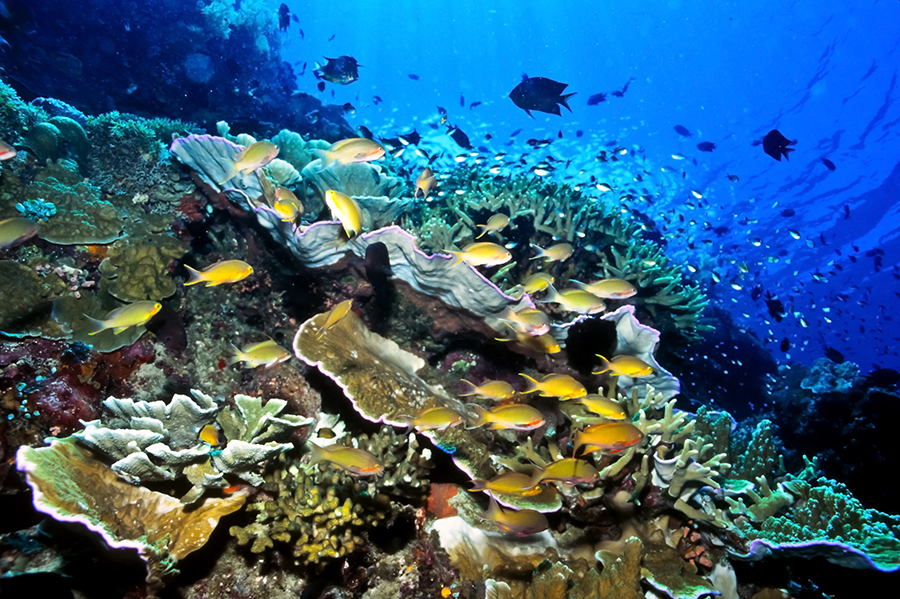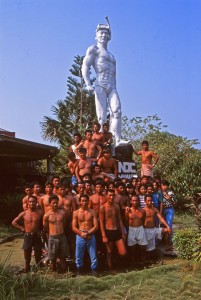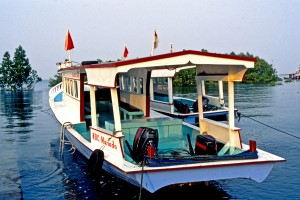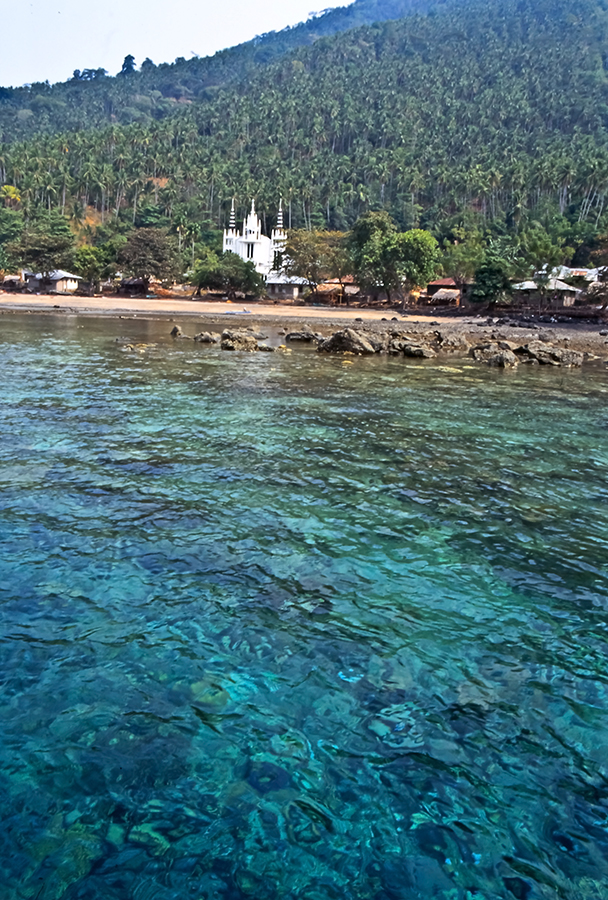 Sitting here looking out my window as the snow comes down outside got me thinking about some of my very excellent warm water dives in Indonesia. I spent some awesome days at the Nusantara Diving Centre located at Molas Beach just outside the town of Manado on the scenic north end of the island of Sulawesi, a tropical paradise split in two by the equator. This area is just south of the Philippines in the Celebes Sea and it’s home to the Bunaken National Park that includes, among others, the small islands of Bunaken, Manado Tua, Siladen, Montehage, and Nain.
Sitting here looking out my window as the snow comes down outside got me thinking about some of my very excellent warm water dives in Indonesia. I spent some awesome days at the Nusantara Diving Centre located at Molas Beach just outside the town of Manado on the scenic north end of the island of Sulawesi, a tropical paradise split in two by the equator. This area is just south of the Philippines in the Celebes Sea and it’s home to the Bunaken National Park that includes, among others, the small islands of Bunaken, Manado Tua, Siladen, Montehage, and Nain.
I made five trips to this area beginning in 1993 and ending in 1999. I stayed on site for a minimum of two weeks each time. After paying for the airfare, and spending two to three days in transient each way, it was prudent to maximize ground and diving time. I’ve utilized both Singapore Airlines, and Garuda Indonesia for travel, and both were very accommodating. On the way over I recommend the connections using Singapore Air to fly to Singapore Changi Airport, over night in the Transit Hotel in Terminal 2 there, and then fly Garuda to Sam Ratulong International Airport on Manado the next morning. On the way home I used to make a stay over in Singapore to be a tourist before heading home.
An International passport is required for all U.S. citizens. At the time I visited no special vaccinations were required, but it’s best to obtain anti-malaria medication. Check with your physician for this. Bring quality mosquito repellents, too. You should update the following information, but when I visited Manado the unit of currency was the rupiah, and traveler’s checks and credit cards were accepted at all the diving centers. The climate is tropical requiring only light casual clothing, but don’t forget your sunscreen. I recommend you bring as much of your diving gear as possible with the exception of weights, which are usually provided on site. Tanks are also provided as part of the diving package. The water temperature is in the low 80’s so a tropical wetsuit will keep you warm. Bring a full suit though, to protect your arms and legs from brushing against stinging plants and corals. You will also need an International Electricity Converter for any rechargeable items.
 NDC staff will provide all airport transits and later transportation to Manado to shop. You can get a taxi, or take local bus service, when returning from town to the center. Upon arrival you’ll receive an orientation outlining diving/snorkeling and meal schedules. Breakfast begins at 0700 and features fresh tropical fruit, cereal, toast and eggs. Afterwards your panga crew will load your gear on board for a 0900 departure to the dive site. Lunch is usually a selection from the last night’s dinner leftovers supplemented with fresh fruit, and it’s served either on the boat or ashore at one of the nearby islands. Dinner begins at 1900 after returning from the dive. Dinner menus vary but usually feature fresh fish and tasty local dishes. There’s plenty of good food so no one goes hungry. The local beer is a light brew called Bintang. It has its roots from early Dutch settlers, and it’s delicious. There is a dinner bar where cocktails are available. The wine selection is limited though, so consider buying your own at the duty free shop in Singapore to bring with you. Telephone, fax, and email services are available at the office as well as safe deposit boxes to store valuables.
NDC staff will provide all airport transits and later transportation to Manado to shop. You can get a taxi, or take local bus service, when returning from town to the center. Upon arrival you’ll receive an orientation outlining diving/snorkeling and meal schedules. Breakfast begins at 0700 and features fresh tropical fruit, cereal, toast and eggs. Afterwards your panga crew will load your gear on board for a 0900 departure to the dive site. Lunch is usually a selection from the last night’s dinner leftovers supplemented with fresh fruit, and it’s served either on the boat or ashore at one of the nearby islands. Dinner begins at 1900 after returning from the dive. Dinner menus vary but usually feature fresh fish and tasty local dishes. There’s plenty of good food so no one goes hungry. The local beer is a light brew called Bintang. It has its roots from early Dutch settlers, and it’s delicious. There is a dinner bar where cocktails are available. The wine selection is limited though, so consider buying your own at the duty free shop in Singapore to bring with you. Telephone, fax, and email services are available at the office as well as safe deposit boxes to store valuables.
 The diving schedule features two tank dives daily supplemented with unlimited snorkeling. You can purchase an extra night dive for a small fee upon request. There are a number of great diving sites spread throughout the Bunaken National Park, and I plan to describe these in more detail in subsequent blogs. The ocean is a tropical treasure house of wildlife whose natural wonders will never cease to amaze you.
The diving schedule features two tank dives daily supplemented with unlimited snorkeling. You can purchase an extra night dive for a small fee upon request. There are a number of great diving sites spread throughout the Bunaken National Park, and I plan to describe these in more detail in subsequent blogs. The ocean is a tropical treasure house of wildlife whose natural wonders will never cease to amaze you.
 Each island is surrounded by a white sandy beach that shelves slowly out to a barrier reef drop off. The top of the reef wall is generally at around 10 feet, and the wall drops off in varying degrees from there. Visibility usually exceeds 100 feet, but because of the large tidal differences you’ll be diving in strong currents. That’s part of the ambience though, since almost all dives are drift dives where the boat drops you off and you drift along the reef with the current. Then the boat picks you up at the end of the dive. A good buoyancy compensator is a necessity to keep you neutral as you float along the reef. Unique hard and soft corals, beautiful sponges of many types, and a tremendous variation in fish and other marine life make each dive a special experience.
Each island is surrounded by a white sandy beach that shelves slowly out to a barrier reef drop off. The top of the reef wall is generally at around 10 feet, and the wall drops off in varying degrees from there. Visibility usually exceeds 100 feet, but because of the large tidal differences you’ll be diving in strong currents. That’s part of the ambience though, since almost all dives are drift dives where the boat drops you off and you drift along the reef with the current. Then the boat picks you up at the end of the dive. A good buoyancy compensator is a necessity to keep you neutral as you float along the reef. Unique hard and soft corals, beautiful sponges of many types, and a tremendous variation in fish and other marine life make each dive a special experience.
The Nusantara Diving Centre (NDC) maintains a webpage listing useful information at http://www.ndcresort.com/index.htm that will provide you with current rates, and let you make reservations. There is a contact person cited if you need additional information. There are also a number of other diving resorts available for this area. Since I was happy with NDC I didn’t visit those, but lots of information is available on the web.
I love this place and can’t say enough about the pleasures I’ve experienced here. I will outline many of these in future blogs featuring my favorite dives in more detail. If you’re thinking about experiencing a special dive, I recommend you try the area around Manado.
